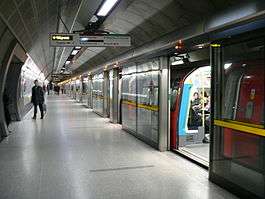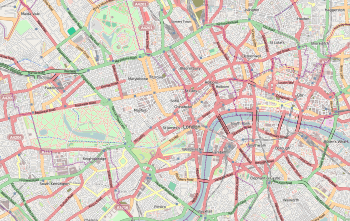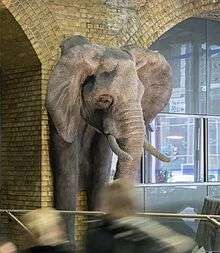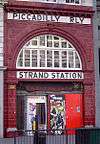Waterloo tube station
Waterloo is a London Underground station located beneath Waterloo National Rail station. As of 2018, it is the 4th busiest station on the London Underground, with 74.54 million users.[4] It is served by four lines: the Bakerloo, Jubilee, Northern and Waterloo & City lines.
| Waterloo | |
|---|---|
 Jubilee line platforms | |
 Waterloo Location of Waterloo in Central London | |
| Location | Waterloo |
| Local authority | London Borough of Lambeth |
| Managed by | London Underground |
| Owner | London Underground |
| Number of platforms | 8 |
| Accessible | Yes (Jubilee line and southbound Bakerloo line only)[1] |
| Fare zone | 1 |
| OSI | Waterloo Waterloo East London Eye Pier |
| London Underground annual entry and exit | |
| 2014 | |
| 2015 | |
| 2016 | |
| 2017 | |
| 2018 | |
| Railway companies | |
| Original company | Waterloo & City Railway |
| Key dates | |
| 8 August 1898 | W&CR opened station |
| 10 March 1906 | BS&WR started |
| 13 September 1926 | CCH&R started |
| 20 November 1999 | Jubilee line started |
| Other information | |
| External links | |
| WGS84 | 51.5025°N 0.1130°W |
The station is situated in fare zone 1 and is located near the South Bank of the River Thames, in the London Borough of Lambeth. It is within walking distance of the London Eye.
History
The first Underground Line at Waterloo was opened on 8 August 1898 by the Waterloo & City Railway (W&CR), a subsidiary of the owners of the main line station, the London and South Western Railway (L&SWR).[5] The W&CR, nicknamed "The Drain",[6] achieved in a limited way the L&SWR's original plan of taking its tracks the short distance north-east into the City of London.
On 10 March 1906, the Baker Street & Waterloo Railway (now the Bakerloo line) was opened.[5] On 13 September 1926, the extension of the Hampstead & Highgate line (as the Charing Cross branch of the Northern line was then known) was opened from Embankment to the existing City and South London Railway station at Kennington with a new station at Waterloo.[5]
As a subsidiary of the L&SWR and its successor, the Southern Railway, the W&CR was not a part of the London Underground system. Following nationalisation of the main line railway companies in 1948, it became part of British Railways (later British Rail).
In 1951, the Leslie Green designed York Road entrance of the Underground station was demolished[7] and replaced by a new entrance on the other side of the road, part of the Festival of Britain site.[8] As part of this work, the lifts were replaced by escalators to this new entrance.[9] This entrance also served the Waterloo Air Terminal.[10] In the 1960s, the entrance building became integrated into the Shell Centre complex.[11]
In March 1965, a British Rail and London Transport joint planning committee published "A Railway Plan for London" that included a recommendation to revive a plan from the 1900s for an extension of the Piccadilly line's Aldwych branch to Waterloo.[12][13] London Transport had already sought parliamentary approval to construct tunnels from Aldwych to Waterloo in November 1964,[14] and in August 1965, parliamentary powers were granted. Detailed planning took place, although public spending cuts led to postponement of the scheme in 1967 before tenders were invited.[15]
1990s refurbishment
The Underground station was comprehensively refurbished in the early 1990s as part of the construction of Waterloo International station for international Eurostar services, with the Main Ticket hall underneath the railway concourse expanded and connected to the new International station.[11][16] The platforms were also decorated with artwork by Christopher Tipping on the theme of the nearby National Theatre, although these murals have since been removed.[17]
The Waterloo & City line was closed for 2 months in 1993 to be upgraded with new trains and the four rail electrical system of the London Underground.[18] The ownership of the line was transferred from Network SouthEast to the Underground on 1 April 1994 as part of the privatisation of British Rail.[19] Due to an Easter shut-down, the first Underground service on the line was on 5 April 1994.[5]
Jubilee Line extension
The Jubilee Line Extension was constructed in the 1990s to extend the Jubilee line from Green Park to Stratford, via the then new Canary Wharf development. Opening in September 1999, the new Jubilee line station was designed by in-house JLE Project Architects, overseen by Roland Paoletti.[20]
The design of the station was complex, due to the distance between the existing Bakerloo and Northern lines and the extension - as well as the railway station located above.[11][20] To connect the station together, a 115-metre (377 ft) moving walkway link was installed, one of only two on the Underground; the other gives access to the Waterloo & City line platform at Bank station.[21] The colonnade on Waterloo Road underneath the cab road of the station - originally used for goods deliveries and a bus stand - was also repurposed as the new Jubilee line ticket hall.[11][20]
The station was temporarily the western terminus of the extension running from Stratford in east London, before the final section to link the extension to the original line was opened between Waterloo and Green Park on 20 November 1999.[5]

A sculpture of an Elephant by artist Kendra Haste is located between the escalators in the Colonnade Ticket Hall. The sculpture was purchased by London Underground, having been originally commissioned as part of its Platform for Art programme and set up at the Gloucester Road tube station.[22][23]
Southbank Place
As part of the redevelopment of the Shell Centre into "Southbank Place" by Canary Wharf Group and Qatari Diar, the existing York Road entrance was closed in 2015 to be completely rebuilt.[24] The new, larger York Road entrance, which also included an additional escalator - reopened in May 2019.[25][26]
Ticket Halls
The station has 3 ticket halls and 5 main entrances. Additional entrances to the Underground station are available in peak hours via a subway underneath the railway station from station platforms.[27][28]
- Main Ticket Hall, located underneath the railway concourse.
- Colonnade/Jubilee Line Ticket Hall, located at street level on Waterloo Road, underneath the cab road of the railway station. This ticket hall opened in 1999 as part of the Jubilee Line Extension.[11]
- York Road Ticket Hall, located at street level on York Road in the Southbank Place development, to the west of the railway station.[8]
The three ticket halls are connected via escalators, passageways and the moving walkway to the four sets of platforms.
Future
Elizabeth House, located directly adjacent to the mainline railway station, is being redeveloped by HB Reavis. As part of this redevelopment, a lift shaft will be constructed to provide step free access to the Northern line.[29]
Connections
The station is served by London Buses routes 1, 26, 59, 68, 76, 77, 139, 168, 172, 176, 188, 211, 243, 341, 381, 507, 521 and X68 and night routes N1, N68, N76, N171, N343 and N381.
See also
References
- "Step free Tube Guide" (PDF). Transport for London. May 2020. Archived (PDF) from the original on 7 August 2020.
- "Out of Station Interchanges" (XLS). Transport for London. 19 February 2019.
- "Multi-year station entry-and-exit figures (2007-2017)" (XLSX). London Underground station passenger usage data. Transport for London. January 2018. Retrieved 22 July 2018.
- "Station Usage Data" (CSV). Usage Statistics for London Stations, 2018. Transport for London. 21 August 2019. Retrieved 27 April 2020.
- Rose, Douglas (1999). The London Underground, A Diagrammatic History. Douglas Rose/Capital Transport. ISBN 1-85414-219-4.
- Wolmar, Christian (2004). "Deep Under London". The Subterranean Railway: How the London Underground Was Built and How It Changed the City Forever. Atlantic Books. p. 146. ISBN 1-84354-023-1.
- "B/W print; Waterloo Underground station exterior, Bakerloo line, Jul 1907 - Dec 1907". London Transport Museum. Retrieved 26 February 2020.
- "Waterloo tube station reopens its Southbank entrance". www.ianvisits.co.uk. Retrieved 26 February 2020.
- "The Transport for London (Waterloo Station) Order 2005". www.legislation.gov.uk. Retrieved 26 February 2020.
- "The Waterloo Air Terminal". A London Inheritance. 18 January 2015. Retrieved 26 February 2020.
- Mitchell, R. (2009). Jubilee line extension ; From concept to completion. Thomas Telford Ltd. ISBN 978-0-7277-3813-4. OCLC 608572718.
- Horne, Mike (2000). The Jubilee Line. Capital Transport. pp. 31–33. ISBN 1-85414-220-8.
- British Railways Board/London Transport Board (March 1965). A Railway Plan for London (PDF). p. 23.
- "Parliamentary Notices". The Times (56185): 2. 3 December 1964. Archived from the original on 27 September 2012.
- Connor, J.E. (2001) [1999]. London's Disused Underground Stations. Capital Transport. p. 99. ISBN 1-85414-250-X.
- "STOCK IMAGE - WATERLOO UNDERGROUND STATION Showing MAUD DALEY, longest serving member of staff, unveiling a plaque to open the ticket hall in the newly refurbished Waterloo Underground Station. COMPULSORY CRE... by www.DIOMEDIA.com". Diomedia. Retrieved 26 February 2020.
- "Poster; A change of scene under the National Theatre, unknown, 1988". London Transport Museum. Retrieved 26 February 2020.
- "CULG - Waterloo & City Line". www.davros.org. Retrieved 26 February 2020.
- "Waterloo & City line, Dates". Clive's Underground Line Guides. Retrieved 20 July 2008.
- Powell, Ken, 1947- (2000). The Jubilee Line extension. London: Laurence King. ISBN 1-85669-184-5. OCLC 42444848.CS1 maint: multiple names: authors list (link)
- "CULG - Vertical transport". www.davros.org. Retrieved 26 February 2020.
- "ELEPHANT". www.kendrahaste.co.uk. Retrieved 26 February 2020.
- "Why Is There An Elephant In Waterloo Station?". Londonist. 4 February 2015. Retrieved 27 February 2020.
- "Waterloo Tube Station's York Road entrance to shut for 3 years". London SE1. 20 October 2015. Retrieved 26 February 2020.
- "South Bank entrance reopens at Waterloo Underground station". Transport for London. 21 May 2019. Retrieved 26 February 2020.
- "York Road entrance to Waterloo Tube reopens after 3.5 years". London SE1. 29 May 2019. Retrieved 26 February 2020.
- "3D maps of every Underground station – TUVW". www.ianvisits.co.uk. Retrieved 26 February 2020.
- "Waterloo Station Map" (PDF). Network Rail. September 2019.
- Hatts, James (16 October 2019). "Waterloo: latest scheme for Elizabeth House site approved". London SE1. Retrieved 26 February 2020.
External links
| Wikimedia Commons has media related to Waterloo tube station. |
| Preceding station | Following station | |||
|---|---|---|---|---|
towards Harrow & Wealdstone | Bakerloo line | towards Elephant & Castle |
||
towards Stanmore | Jubilee line | towards Stratford |
||
| Northern line Charing Cross Branch | ||||
| Terminus | Waterloo & City line | Terminus |
||
| Abandoned Plans | ||||
| Aldwych towards Holborn |
Piccadilly line Proposed extension from Aldwych (never constructed) |
Terminus | ||
